In the dynamic world of technology, questions arise and solutions are sought. Stack Overflow stands as a beacon, guiding individuals through their technical difficulties with insights from experts around the globe.
In this blog, we dive into the world of Varnish, a pivotal tool for caching, web & API acceleration and content delivery, through the lens of the most asked and intriguing questions on Stack Overflow.
In our new webinar below, Pål Hermunn Johansen, a Varnish Core Developer and Varnish Software's R&D Team Lead for the C-team, and Thijs Feryn, Varnish Software's Technical Evangelist, discuss the top 5 burning questions from the community.
Grace
The first question Pål and Thijs talk about is "grace", which is Varnish's implementation of HTTP's "stale while revalidate" behavior.
They explain what it is, how it is a tradeoff between serving outdated content and asynchronously fetching the updated version, and how to configure grace in Varnish
Banning
When it comes to explicitly forcing outdated content from the cache, Varnish is second to none. While purging of individual objects based on the URL is a common practice in Varnish, Pål and Thijs will talk about "banning" in Varnish.
They explain how you can remove multiple objects from the cache using a single ban expression, but they also cover the typical problems that people encounter when doing this.
And of course, they talk about one of the main traps people fall into: request bands versus object bans.
Debugging 503 errors
When something unexpected happens, Varnish tends to return a "503 Service Unavailable" error. As a Varnish user you might recognize the standard 503 output template containing the infamous "Guru meditation" text.
Pål and Thijs dive a bit deeper into these errors and explain how you can debug the root cause of this fairly vague error message.
Stripping off cookies
The standard behavior of Varnish regarding cookies is a very cautious one. Caching responses that depend on cookie values could lead to highly personalized data being cached.
This is one of the most typical issues people encounter and Pål and Thijs explain how you should approach the removal of cookies to maintain the balance between a high cache hit rate and using cookies for personalized output.
How to check if Varnish is being used
As reverse caching proxy, often times Varnish is not really visible to the end user. In the chain of servers, ranging from TLS proxy, to cache, to web server, it's not always clear if caching takes place.
The 5th and last question Pål and Thijs are going to answer is how to know if Varnish is running. However, it's about more than ensuring the Varnish service is running, it's also about debugging which ports are in use and if the system is properly caching.
Reach out to us for more answers
If you have any further questions don’t hesitate to reach out to our team of experts.
/VS-logo-2020-197x60.png?width=136&height=60&name=VS-logo-2020-197x60.png)




